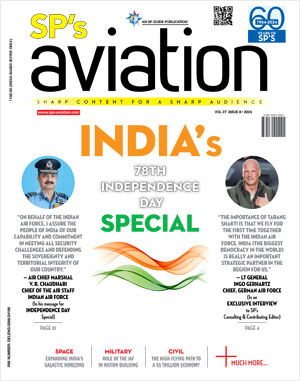INDIAN ARMED FORCES CHIEFS ON OUR RELENTLESS AND FOCUSED PUBLISHING EFFORTS

SP Guide Publications puts forth a well compiled articulation of issues, pursuits and accomplishments of the Indian Army, over the years

"Over the past 60 years, the growth of SP Guide Publications has mirrored the rising stature of Indian Navy. Its well-researched and informative magazines on Defence and Aerospace sector have served to shape an educated opinion of our military personnel, policy makers and the public alike. I wish SP's Publication team continued success, fair winds and following seas in all future endeavour!"

Since, its inception in 1964, SP Guide Publications has consistently demonstrated commitment to high-quality journalism in the aerospace and defence sectors, earning a well-deserved reputation as Asia's largest media house in this domain. I wish SP Guide Publications continued success in its pursuit of excellence.
Special operations in Myanmar
 |
By Air Marshal B.K. Pandey (Retd) Former Air Officer Commanding-in-Chief of Training Command, IAF |
In the early hours of June 9 this year, Indian Special Forces carried out surgical operations deep inside Myanmar territory. Their targets were two camps of the Nationalist Socialist Council of Nagaland (Khaplang) and allied insurgent groups. As revealed by Army Headquarters in a briefing to the media, the cross-border operations by the Special Forces were mounted in retaliation to the killing of 18 Indian Army personnel a few days earlier by the Naga insurgents. Besides, the operations in Myanmar were pre-emptive in nature as there were reliable intelligence reports of planning by the insurgents of further attacks on Indian forces inside the Indian territory.
The swift response by the Indian security establishment to the massacre of Indian soldiers on June 4, 2015, is generally being regarded as a positive change in the policy of the Indian Government in dealing with terrorists, militants or anti-national elements. While the decisive response by the Indian security establishment is being lauded in India it has evoked equally vicious and offensive response from Pakistan that was clearly rattled. While the planning and conduct of the operations reflects professionalism of a high order, it is debatable whether the Government of India ought to have indulged in chest thumping as it did, as also permitted the media blitz.
Though not openly admitted by the government, it is understood that cross-border operations classified as ‘hot pursuit’ into Myanmar have been undertaken a number of times in the past by the Indian Special Forces to target insurgent groups. The Government of Myanmar has been aware of such operations, but has not voiced protest as it does not support the insurgent groups. It therefore prefers to let the Indian forces tackle these elements as they deem fit. However, in the past, the Government of India has totally refrained from allowing such operations to come into the public domain primarily to obviate embarrassment to the Government of Myanmar. Such operations of clandestine nature are sensitive in character and require careful and deft backroom diplomacy. No government would like to publicly acknowledge acceptance of undercover operations in their territory by the forces of another country. Especially in the case of Myanmar whose constitution does not permit operations by foreign forces on their soil, publicising of covert operations with indications that these were undertaken with tacit approval of the government, would undoubtedly cause serious embarrassment. This is what seems to have happened as the Government of Myanmar has expressed annoyance at the unprecedented publicity of the episode by the Government of India in the Indian media.
The operations into Myanmar by the Indian Special Forces were essentially covert in nature and in all fairness to the Government of Myanmar, the Indian Government ought to have ensured that the exercise remained covert.





